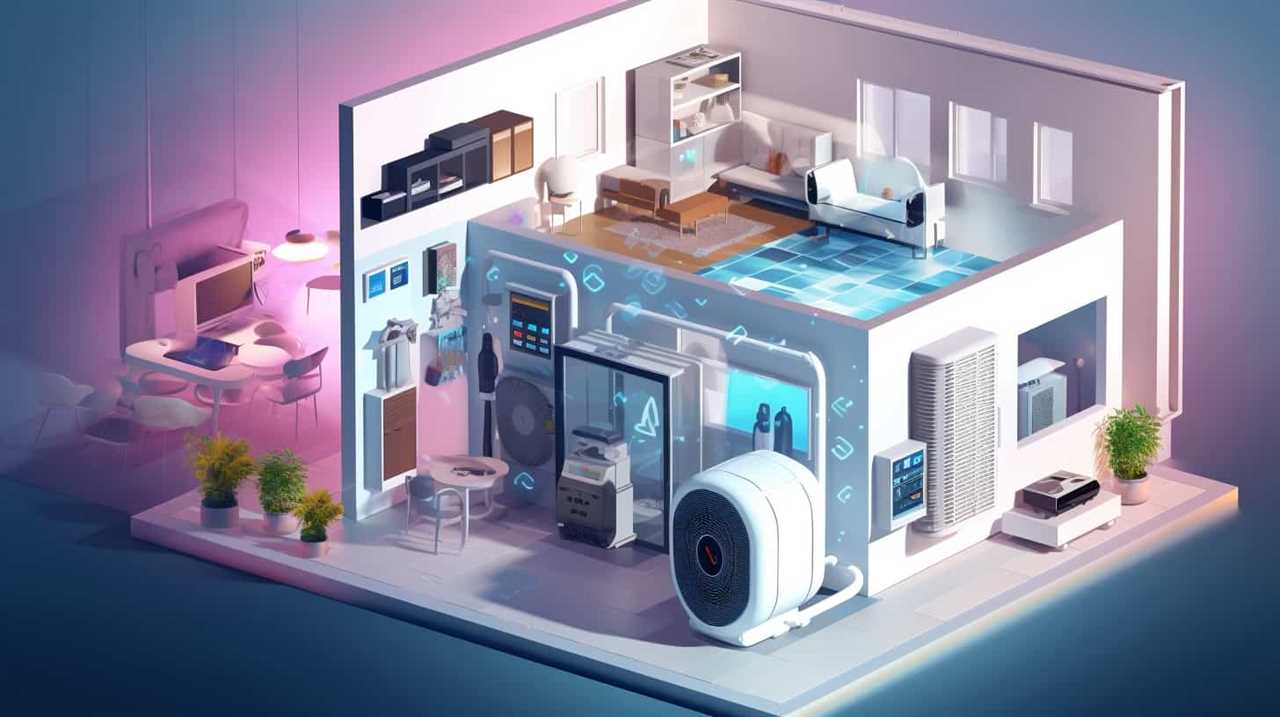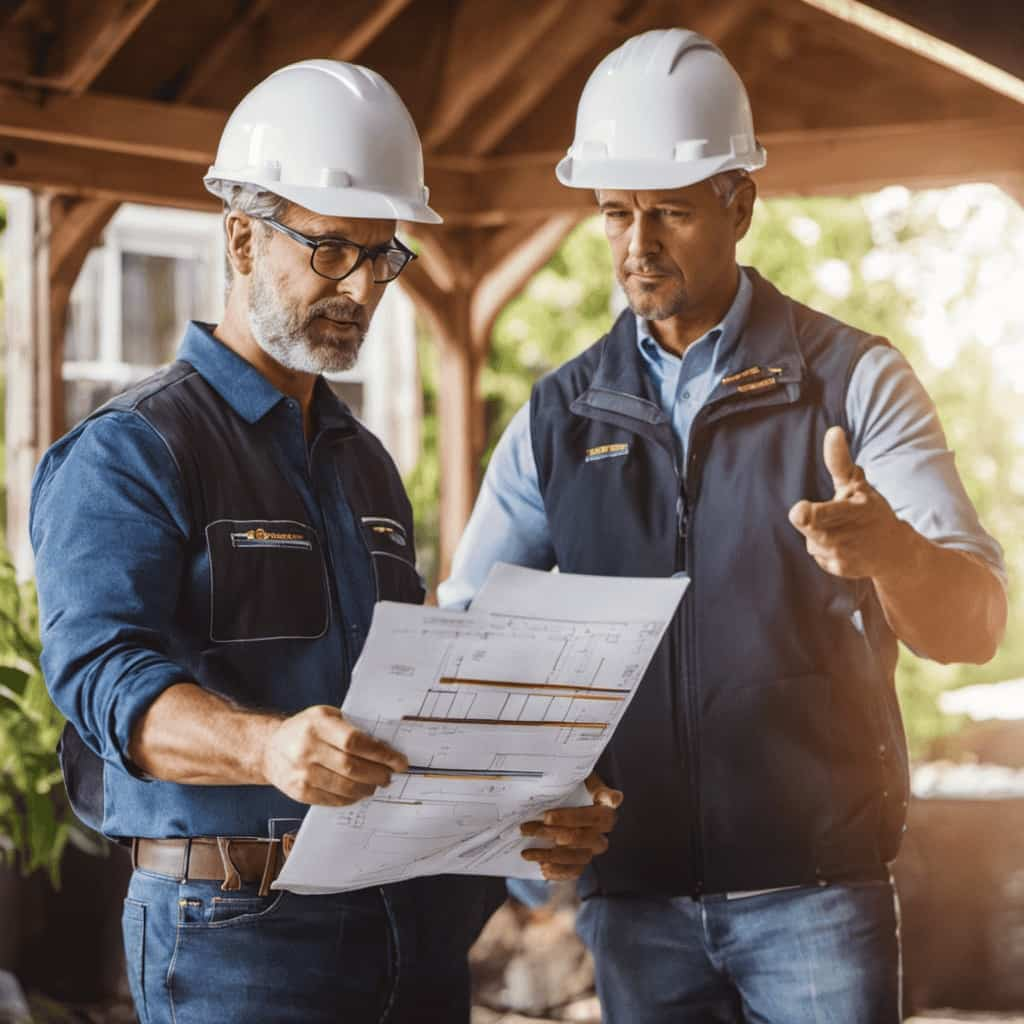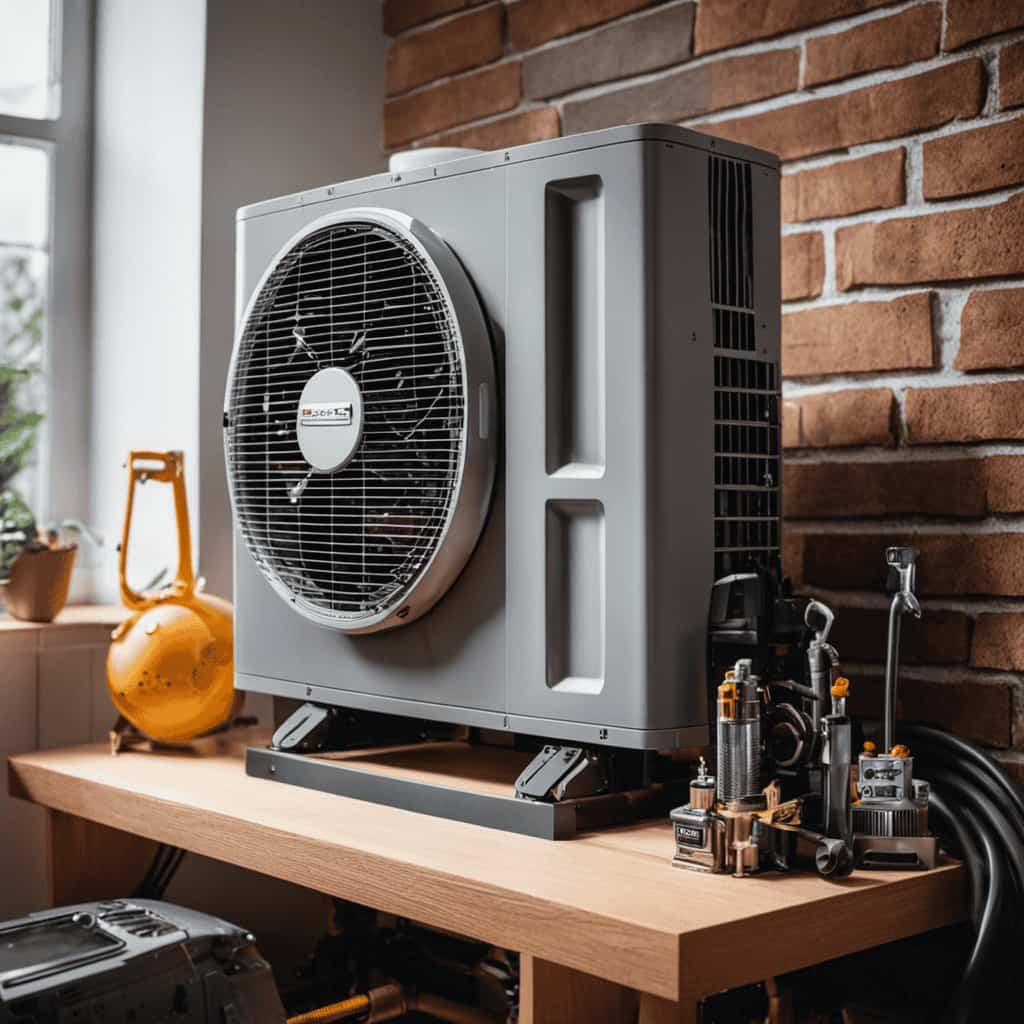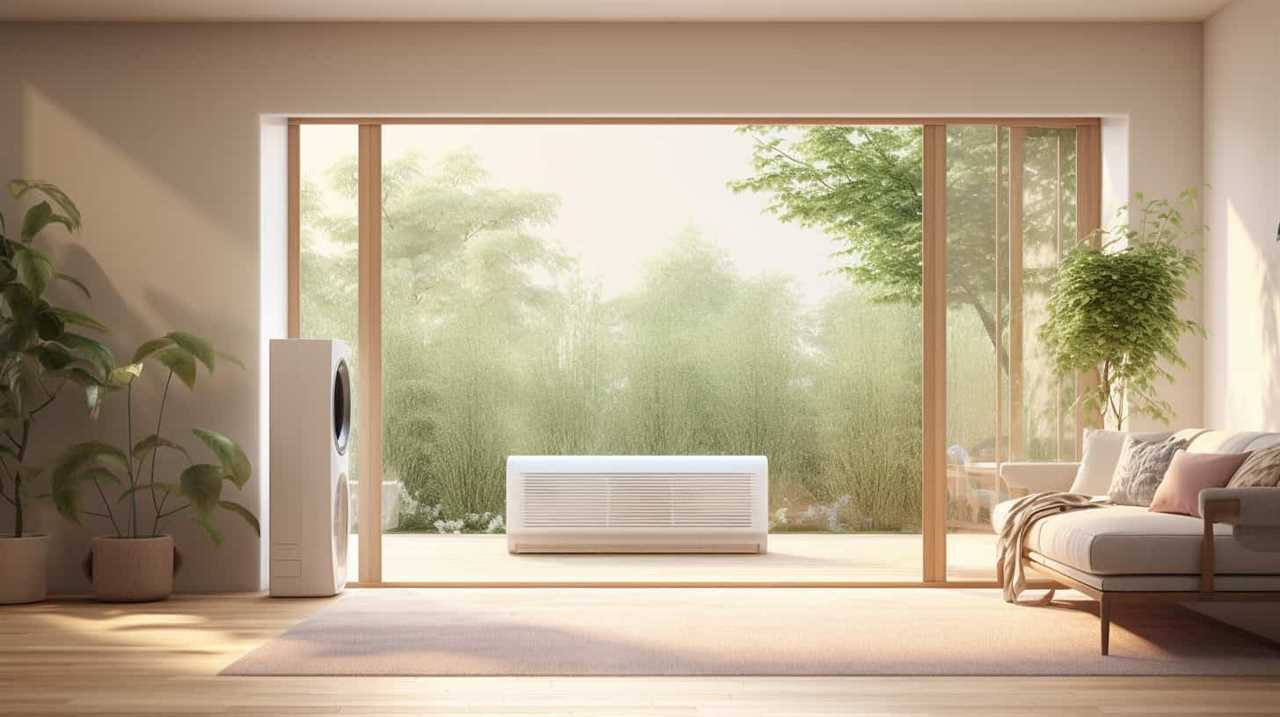We’re all familiar with the discomfort that arises when our heat pump breaks down during an intensely hot day or on a bitterly cold winter evening.
But fear not, because in this article, we have rounded up the essential heat pump maintenance tips to ensure optimal climate control in your home.
From cleaning air filters to checking electrical connections, we’ve got you covered.
So, sit back, relax, and let us guide you through the steps to keep your heat pump running smoothly all year round.

Key Takeaways
- Regular heat pump maintenance is important for optimal functioning, longevity, and energy efficiency.
- Signs that your heat pump needs maintenance include strange noises, poor airflow, and frequent cycling on and off.
- Troubleshooting strange noises involves checking for loose or damaged fan blades, faulty compressors, or refrigerant leaks.
- Regular maintenance tasks include cleaning and changing air filters, checking and cleaning outdoor coils, inspecting and lubricating the fan motor, testing and calibrating the thermostat, checking and tightening electrical connections, evaluating and adjusting refrigerant levels, and clearing and cleaning the condensate drain.
Understanding the Importance of Regular Heat Pump Maintenance
We need to understand the importance of regular heat pump maintenance.
Proper maintenance is essential for the optimal functioning of your heat pump and to ensure its longevity.
Regular maintenance helps prevent costly repairs and breakdowns, saving you both time and money.
It also improves the energy efficiency of your heat pump, lowering your utility bills.

DIY heat pump maintenance tips can be useful in keeping your system in good condition. These include regularly cleaning or replacing air filters, cleaning the outdoor unit, checking and cleaning the coils, and ensuring proper airflow.
Additionally, scheduling professional preventive maintenance at least once a year is crucial.
A qualified technician can identify and fix any issues, perform necessary adjustments, and ensure that your heat pump is running at its best.
Signs Your Heat Pump Needs Maintenance
When it comes to ensuring the optimal performance of your heat pump, paying attention to signs that indicate the need for maintenance is crucial.

Strange noises coming from your heat pump can be a clear indication that something is amiss and requires attention.
Poor airflow is another sign that your heat pump may need maintenance, as reduced airflow can greatly impact its efficiency.
Additionally, if your heat pump is frequently cycling on and off, it could be a sign of underlying issues that need to be addressed.
Strange Noises Indicate
If you hear strange noises coming from your heat pump, it’s a clear indication that maintenance is needed. Strange noises can be caused by various issues, and troubleshooting them is essential to ensure the proper functioning of your heat pump.

One common cause of heat pump malfunction is a loose or damaged fan blade. If you hear a rattling or clanking noise, it could indicate a problem with the fan blade.
Another possible cause is a faulty compressor, which may produce a loud banging or knocking sound.
Additionally, a hissing or bubbling noise could indicate a refrigerant leak. It’s important to address these issues promptly to prevent further damage and potential breakdown of your heat pump.
Moving forward, poor airflow reduces efficiency, so let’s discuss how to improve it.

Poor Airflow Reduces Efficiency
Poor airflow reduces the efficiency of our heat pump, so it’s important to recognize the signs that indicate maintenance is needed. Troubleshooting airflow issues can help increase the efficiency of our system and ensure optimal climate control. Here are three signs to watch out for:
Reduced airflow: If you notice weak or limited airflow coming from your vents, it could be a sign of a clogged air filter or a problem with the blower fan. Cleaning or replacing the air filter and inspecting the blower fan can help improve airflow.
Uneven temperature distribution: If some rooms in your home feel cooler or warmer than others, it may indicate airflow issues. This could be caused by blocked vents or ductwork problems. Inspecting and cleaning vents and checking for any obstructions in the ductwork can help resolve this issue.
Excessive dust: If you notice an excessive amount of dust accumulating on surfaces or floating in the air, it could be a result of poor airflow. Dust buildup can hinder the efficiency of the heat pump. Regularly cleaning and maintaining the system can help prevent this.

Frequent Cycling Indicates Issues
Do you notice your heat pump frequently cycling on and off? If so, it may be a sign that your heat pump needs maintenance.
Frequent cycling is one of the common heat pump issues that homeowners may encounter. This issue can be caused by various factors, such as a faulty thermostat, low refrigerant levels, or a clogged air filter.
To troubleshoot and resolve this problem, it’s important to start by checking the thermostat settings and ensuring that they’re correctly set. If the issue persists, it may be necessary to clean or replace the air filter and check the refrigerant levels.
Additionally, it’s recommended to schedule regular maintenance to prevent future problems and ensure optimal performance of your heat pump.

Cleaning and Changing Air Filters
When maintaining our heat pump, we should regularly clean and change the air filters. Proper air filter maintenance is crucial for the efficient operation of our heat pump and the overall quality of indoor air. Here are three important things to know about cleaning and changing air filters:
Regular cleaning: Dust and debris can accumulate on the air filters over time, reducing their effectiveness. It’s important to clean the filters at least once a month to ensure proper airflow and prevent the buildup of contaminants.
Filter replacement: Despite regular cleaning, air filters will eventually reach a point where they need to be replaced. This usually happens every three to six months, depending on factors such as air quality and usage. Replacing the filters ensures optimal performance and helps maintain good indoor air quality.
Filter type: Choosing the right air filter is essential. There are various types available, such as fiberglass, pleated, and electrostatic filters. Consider factors like air quality concerns, allergies, and the specific needs of your heat pump when selecting a filter.

By regularly cleaning and changing air filters, we can ensure the efficiency and longevity of our heat pump while promoting healthy indoor air quality.
Now, let’s move on to the next section about checking and cleaning outdoor coils.
Checking and Cleaning Outdoor Coils
To ensure the proper functioning of our heat pump, we need to regularly check and clean the outdoor coils. Outdoor coil maintenance is crucial as these coils play a vital role in the heat transfer process. Over time, the coils can become clogged with dirt, dust, and debris, reducing their efficiency and hindering the overall performance of the heat pump.
To clean the coils, start by turning off the power to the unit. Then, gently brush the coils using a soft brush to remove any loose debris. Next, use a coil cleaner specifically designed for outdoor coils and follow the manufacturer’s instructions. Rinse the coils thoroughly with water to remove any remaining dirt or cleaner residue. Finally, let the coils dry completely before restoring power.

Proper coil cleaning techniques will ensure optimal heat pump performance and efficiency.
Now that we’ve discussed checking and cleaning the outdoor coils, let’s move on to the next important maintenance task: inspecting and lubricating the fan motor.
Inspecting and Lubricating Fan Motor
Before we proceed with the maintenance tips, let’s start by inspecting and lubricating the fan motor to ensure its proper functioning. The fan motor plays a crucial role in the heat pump system, as it circulates air throughout the unit and helps regulate the temperature.
Here are three important steps to follow when inspecting and lubricating the fan motor:

Visual Inspection: Begin by visually inspecting the fan motor for any signs of damage, such as loose or worn-out parts, excessive dirt or debris, or unusual noises during operation. This will help identify any potential issues that may require further attention.
Cleaning: Use a soft brush or cloth to clean the fan blades and motor housing, removing any dust, dirt, or debris that may have accumulated over time. Regular cleaning ensures optimal airflow and prevents the motor from overheating.
Lubrication: Apply a few drops of lubricating oil to the fan motor’s oil ports, which are usually located on each end of the motor. This lubrication helps reduce friction and ensures smooth operation of the fan motor.
By following these steps, you can maintain the efficiency and longevity of your heat pump’s fan motor.

Now that we’ve inspected and lubricated the fan motor, let’s move on to the next crucial step: testing and calibrating the thermostat.
Testing and Calibrating Thermostat
Now let’s move on to testing and calibrating the thermostat to ensure accurate temperature control in our heat pump system. Proper thermostat functionality is crucial for the efficient operation of the heat pump.
If you notice any issues with temperature control or inconsistent heating or cooling, it may be necessary to troubleshoot the thermostat. Start by checking the thermostat settings and ensuring they’re correctly programmed. Verify that the temperature displayed on the thermostat matches the actual room temperature. If there’s a discrepancy, you may need to recalibrate the thermostat. This can typically be done by following the manufacturer’s instructions or consulting a professional technician.
By troubleshooting and calibrating the thermostat, we can ensure optimal climate control and prevent any potential system malfunctions.

Now, let’s move on to the next step: checking and tightening electrical connections.
Checking and Tightening Electrical Connections
First, we should check and tighten electrical connections to ensure proper functioning of our heat pump system. This step is crucial as electrical connections can become loose over time, leading to poor performance and potential system failures.
Here are three important aspects to consider when checking and tightening electrical connections:
Inspect wiring connections: Carefully examine all electrical wires for signs of wear, damage, or loose connections. Look for any frayed or exposed wires that may pose a safety hazard. Replace any damaged wires and ensure all connections are tight.

Test voltage levels: Use a multimeter to measure the voltage levels across electrical connections. This will help identify any fluctuations or abnormalities that may indicate faulty connections. Ensure proper voltage levels to maintain optimal performance.
Secure terminal connections: Check the terminal connections on the heat pump system and tighten them if necessary. Loose terminal connections can cause intermittent operation and inefficient heating or cooling.
Evaluating and Adjusting Refrigerant Levels
To ensure optimal performance, we should regularly evaluate and adjust the refrigerant levels in our heat pump system. Refrigerant plays a crucial role in the heat transfer process within the system, so it’s essential to maintain the correct levels.
One important aspect of evaluating refrigerant levels is refrigerant leak detection. A refrigerant leak can lead to decreased efficiency and even system failure if left unchecked. By performing regular leak detection, we can identify and address any leaks promptly, ensuring that the refrigerant levels remain within the recommended range.

Additionally, troubleshooting refrigerant flow issues is another important step in maintaining the system’s performance. If the refrigerant flow is restricted or uneven, it can negatively impact the heat transfer process. By addressing any flow issues, we can optimize the system’s efficiency and overall performance.
Regularly evaluating and adjusting refrigerant levels is a vital part of heat pump maintenance, ensuring that the system operates at its best.
Clearing and Cleaning Condensate Drain
We should regularly clear and clean the condensate drain to prevent clogs and ensure optimal functioning of our heat pump system. Neglecting this task can lead to a buildup of debris, which can obstruct the drain and impede the flow of condensed water.
Here are three important steps to clear and clean the condensate drain effectively:

Begin by locating the condensate drain line. It’s usually located near the indoor unit of the heat pump system.
Clear any visible debris from the drain line by using a small brush or a soft cloth. Make sure to remove any accumulated dirt, dust, or other substances that might obstruct the flow of water.
To prevent future clogs, consider using a wet-dry vacuum to suction out any remaining debris from the drain line. This helps to ensure a clear and unobstructed path for the condensed water to flow.
Regularly clearing and cleaning the condensate drain is essential for the proper functioning of our heat pump system, allowing it to efficiently remove moisture from the air and maintain optimal indoor comfort.

Scheduling Professional Heat Pump Tune-Up
When it comes to maintaining optimal performance of your heat pump, regular maintenance is of utmost importance.
Scheduling a professional tune-up for your heat pump ensures that it’s operating at peak efficiency and can help prevent potential issues before they become major problems.
Professional service offers a range of benefits, including thorough inspections, cleaning of components, and identifying any necessary repairs or replacements.
Importance of Regular Maintenance
Regular maintenance is key to ensuring optimal performance and longevity of your heat pump, so it’s important to schedule a professional tune-up. By understanding the maintenance benefits and avoiding common maintenance mistakes, you can keep your heat pump running smoothly all year round.

Here are three important reasons why regular maintenance is crucial for your heat pump:
Improved Efficiency: Regular maintenance helps keep your heat pump operating at its highest efficiency, saving you energy and money on your utility bills.
Longer Lifespan: Proper maintenance extends the lifespan of your heat pump, reducing the need for costly repairs or premature replacement.
Enhanced Comfort: With routine maintenance, your heat pump will consistently deliver the desired heating and cooling comfort, ensuring a comfortable indoor environment for you and your family.

Scheduling a professional tune-up will give you peace of mind, knowing that your heat pump is in good hands and will continue to perform optimally. Don’t overlook the importance of regular maintenance for your heat pump’s longevity and efficient operation.
Benefits of Professional Service
By entrusting our heat pump to professional service, we can ensure its optimal performance and longevity through scheduled tune-ups. While some homeowners may opt for DIY maintenance to save costs, there are several benefits of hiring professionals to handle the task.
Firstly, professional service providers have the expertise and knowledge to identify potential issues and address them before they become major problems. They can also perform thorough inspections and cleanings that may be overlooked in DIY maintenance.
Secondly, professional technicians have access to specialized tools and equipment that may not be readily available to homeowners. This ensures that the heat pump is serviced efficiently and effectively.

Lastly, when comparing the cost of professional service to DIY maintenance, it’s important to consider the potential costs of mistakes or damage that may occur during DIY attempts. Hiring professionals can ultimately save homeowners money in the long run by preventing costly repairs or premature replacement of the heat pump.
Frequently Asked Questions
How Often Should I Schedule a Professional Heat Pump Tune-Up?
We should schedule a professional heat pump tune-up regularly to ensure optimal performance. Regular maintenance is important for the longevity and efficiency of our heat pump. It is part of a comprehensive heat pump maintenance checklist.
Can I Clean and Change Air Filters on My Own, or Do I Need to Hire a Professional?
We can clean our own air filters, but it’s best to hire a professional for air filter replacement. DIY cleaning can remove dust, but a professional ensures optimal performance and prevents damage to the heat pump.
What Are the Signs That My Heat Pump Needs Maintenance?
We can identify common heat pump problems through signs like reduced airflow, strange noises, and inefficient heating or cooling. Regular heat pump maintenance is important to prevent these issues and ensure optimal climate control.

How Frequently Should I Check and Clean the Outdoor Coils?
We should regularly check and clean our outdoor coils to ensure optimal performance of our heat pump. Neglecting this maintenance can lead to reduced efficiency and potential damage to the system.
Is It Necessary to Evaluate and Adjust Refrigerant Levels Regularly, or Only When There Is an Issue With the Heat Pump?
Regular evaluation and adjustment of refrigerant levels are necessary for optimal heat pump performance. Waiting for issues to arise may result in reduced efficiency and potential damage to the system.
What Are the Benefits of Using a Heat Pump for Optimal Climate Control?
When embarking on a heat pump journey for optimal climate control, there are various benefits to reap. Firstly, heat pumps are incredibly energy-efficient, resulting in reduced power consumption and lower utility bills. Additionally, they offer versatile functionality by providing both heating and cooling solutions. Lastly, heat pumps operate quietly, ensuring a peaceful and comfortable environment throughout the year.
Conclusion
So there you have it, folks. Maintaining your heat pump is just a hassle that keeps your climate control system running efficiently and effectively. Who needs that, right?
Just let those air filters get clogged, coils get dirty, and connections loosen up. It’ll be a great surprise when your heat pump breaks down in the middle of winter. But hey, at least you’ll have a chance to schedule that professional tune-up you’ve been putting off.

Happy freezing!









